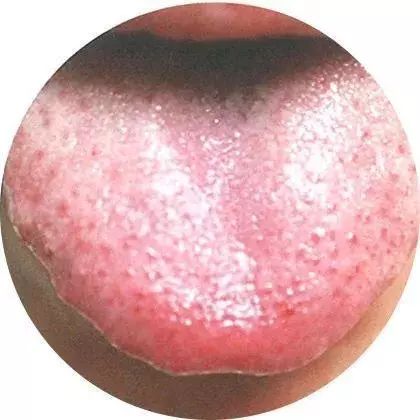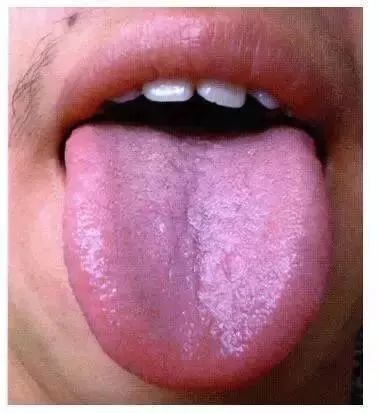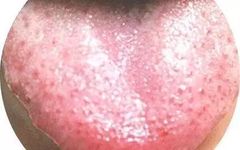Tongue diagnosis primarily includes observing changes in tongue quality and tongue coating. A normal tongue appearance is characterized by a light red color, a moist texture, and a soft, flexible body; the tongue coating is even, thin, white, and moist.

Normal Tongue Appearance
Observation of Tongue Quality: This includes the tongue spirit, tongue color, tongue shape, tongue state, and the sublingual vessels.
1. Tongue Spirit: This includes the flourishing tongue and the withered tongue.
Flourishing Tongue: The tongue is red, moist, and moves freely. A flourishing tongue is said to have spirit, and even in illness, it indicates a good prognosis.
Withered Tongue: The tongue appears dry, dull, and lifeless, lacking vitality and movement. A withered tongue is said to lack spirit, indicating a dangerous prognosis.
2. Tongue Color: This refers to the color of the tongue body. Generally categorized as light red, pale white, red, dark red, and blue-purple.

Light Red Tongue
Light Red Tongue: The tongue body is light red and moist, with a hint of red. A light red tongue indicates a harmonious balance of Qi and blood, commonly seen in healthy individuals; in illness, it often indicates a mild condition.
Light White Tongue: The tongue color is lighter than normal, with more white and less red. If the tongue is entirely white with no blood color, it is termed a withered white tongue. A light white tongue indicates deficiency of Qi and blood. A withered white coating indicates loss of blood and Qi.
Red Tongue: Indicates heat syndrome, possibly due to excessive internal heat; observe if there are red spots on the tongue surface.
Dark Red Tongue: A tongue that is deeper red or slightly dark red is termed a dark red tongue. A dark red tongue indicates excessive internal heat and Yin deficiency with rampant fire.
Blue-Purple Tongue: The entire tongue appears uniformly blue or purple, or there are localized blue-purple spots, all referred to as blue-purple tongue. Blue-purple tongue can present in various forms; if the tongue is pale with a hint of blue-purple, it is termed pale blue-purple tongue; if a red or dark red tongue shows blue-purple, it is termed purple-red or dark purple tongue; localized blue-purple spots on the tongue, varying in size and not raised above the tongue surface, are termed “stagnation spots” or “stagnation points”. Blue-purple tongue indicates poor circulation of Qi and blood.
3. Tongue Shape: This includes the texture and shape of the tongue, such as age, thickness, points, cracks, and teeth marks.
Old and Young: A tongue with rough or shriveled texture, appearing firm and dark, is termed an old tongue, commonly seen in excess conditions; a tongue with delicate texture, appearing swollen and tender, is termed a young tongue, commonly seen in deficiency conditions.
Thick and Thin: A tongue that is larger and thicker than normal, filling the mouth, is termed a thick tongue, indicating internal retention of dampness; a tongue that is thinner and smaller than normal is termed a thin tongue, indicating deficiency of Qi and blood or rampant fire due to Yin deficiency.
Points and Spikes: Points refer to raised red or purple-red spots on the tongue surface, larger ones are termed stars, smaller ones are termed points; spikes refer to enlarged, protruding fungiform papillae forming sharp peaks, resembling thorns, termed thorny tongue. Points and spikes can appear together, hence collectively referred to as point-spike tongue. Point-spike tongue is commonly seen at the tip of the tongue. It indicates excessive Yang heat in the organs or heat in the blood. The location of points can generally indicate where the heat is located, such as points at the tip indicating excessive heart fire; points in the middle indicating severe gastrointestinal heat; points on both sides indicating liver and gallbladder heat.
Cracks: Various shapes of cracks or fissures on the tongue surface, varying in depth and number, are collectively termed cracked tongue. Cracks without coating are often pathological changes; cracks can take shapes like “人”, “|”, or “井”; in severe cases, they may resemble convolutions or be jagged. Cracked tongue is commonly seen in deficiency of essence and blood or rampant fire due to Yin deficiency, or in cases of spleen deficiency and Qi weakness.
Teeth-marked Tongue: The edges of the tongue show impressions from teeth, often accompanied by a swollen tongue body. A teeth-marked tongue indicates spleen deficiency and internal retention of dampness.
4. Tongue State: This refers to the dynamic state of the tongue. A normal tongue state is characterized by flexibility and ease of movement, indicating abundant Qi and blood, smooth meridian flow, and robust organ function. Common pathological tongue states include a soft, weak tongue, a rigid tongue, tremors, protrusion, and shortening.
Soft Tongue: A tongue that is weak and unable to move freely. This is often due to Yin injury or deficiency of Qi and blood.
Rigid Tongue: A tongue that lacks flexibility, is difficult to bend or is stiff, unable to move. This is often seen in heat entering the pericardium, or due to high fever injuring fluids, or phlegm obstructing the meridians.
Deviated Tongue: When the tongue is extended, it deviates to one side, either left or right, termed a deviated tongue, usually more pronounced in the anterior part. A deviated tongue is often seen in stroke or as a precursor to stroke.
Trembling Tongue: A tongue that trembles involuntarily is termed a trembling tongue. In mild cases, it trembles only when extended; in severe cases, it trembles even when not extended. This indicates internal wind of the liver.
Protruding Tongue: A tongue that extends outside the mouth and does not retract immediately is termed protruding tongue; if it extends and retracts repeatedly or licks the lips, it is termed a fidgeting tongue. A protruding tongue often indicates heat in the heart and spleen.
Shortened Tongue: A tongue that is rolled up, tight, and unable to extend, in severe cases, does not reach the teeth. A shortened tongue often appears alongside a soft tongue and indicates a critical condition.
5. Sublingual Vessels: These are the large vessels located on both sides of the lingual frenulum, appearing light purple. Observation of the sublingual vessels mainly focuses on their length, shape, color, thickness, and changes in the small blood vessels under the tongue. If the sublingual vessels are fine and short, pale red in color, and the surrounding small vessels are not prominent, with a pale tongue and sublingual mucosa, this often indicates deficiency of Qi and blood; if the sublingual vessels are coarse and swollen, or appear blue-purple, purple-red, dark red, or purple-black, or if the small vessels under the tongue appear dark red or purple in a net-like pattern, or if the sublingual vessels are varicose with purple nodules of varying sizes, these are all signs of blood stasis, which can be caused by cold, heat, Qi stagnation, phlegm dampness, or deficiency, requiring further analysis in conjunction with other symptoms.
Observation of Tongue Coating: This includes the quality and color of the coating.
1. Coating Quality: This refers to the texture and morphology of the coating. The main observations include the thickness, moisture, greasiness, peeling, distribution, and authenticity of the coating.
Thin and Thick: A coating that allows the tongue body to be faintly seen is termed thin coating, also known as “visible base”; a coating that does not allow the tongue body to be seen is termed thick coating, also known as “invisible base”. Thus, the thickness of the coating is measured by “visible base” and “invisible base”. The thickness of the coating mainly reflects the severity of the pathogenic factor and the depth of the disease.
Moist and Dry: A coating that is moderately moist, neither slippery nor dry, is termed moist coating; a coating that is excessively wet, causing droplet formation, is termed slippery coating; a dry coating that lacks moisture, and may even crack, is termed dry coating; a rough coating that feels coarse to the touch is termed coarse coating. The moisture and dryness of the coating mainly reflect the balance of body fluids.
Greasiness and Decay: A coating that is fine, dense, and adheres tightly to the tongue surface, difficult to remove, is termed greasy coating; a coating that is loose, thick, and resembles a pile of tofu, easily removed, is termed decayed coating. Greasy and decayed coatings mainly indicate the presence of dampness and phlegm.
Peeling and Partial Peeling: A coating that is entirely or partially shed, with a smooth tongue surface underneath, is termed peeling coating; a coating that is partially shed but still shows new granular or papillary growth is termed partially peeling coating. Peeling and partially peeling coatings generally indicate deficiency of stomach Qi, depletion of stomach Yin, or deficiency of both Qi and blood, and are signs of overall weakness.
Partial and Full Coating: A coating that is only distributed on certain parts of the tongue, termed partial coating, while a coating that covers the entire tongue surface is termed full coating. Observing the distribution of the coating can help diagnose the location of the disease. A partial coating often indicates stagnation of pathogenic factors in the corresponding organ; a full coating often indicates widespread pathogenic factors, commonly seen in dampness and phlegm obstruction.
Authentic and False Coating: A coating that adheres tightly to the tongue surface, difficult to remove, or leaves traces when scraped, appearing as if it has grown from the tongue body, is termed authentic coating; if the coating is not firmly attached, easily scraped off, and does not appear to have grown from the tongue, it is termed false coating. Authentic and false coatings can help determine the severity and prognosis of the disease.
2. Coating Color: The main colors are white, yellow, and gray-black, which can appear alone or in combination. Changes in coating color need to be analyzed in conjunction with coating quality, tongue color, and tongue morphology.
White Coating: A white coating on the tongue surface is the most common color, with variations in thickness. White coating can be normal, but in disease, it indicates exterior syndrome, cold syndrome, or damp syndrome, and can also be seen in heat syndrome.
Yellow Coating: A yellow coating on the tongue is termed yellow coating, with variations in lightness and thickness, and often appears alongside red or dark red tongues. Yellow coating indicates heat syndrome or internal syndrome.
Gray-Black Coating: Gray coating and black coating are similar; light black is termed gray coating, while deep black is termed black coating, collectively referred to as gray-black coating. Gray-black coating often develops from white or yellow coating. Gray-black coating indicates excessive heat or internal cold, phlegm dampness, etc., with the color and texture of the coating being important indicators for distinguishing between cold and heat attributes.

